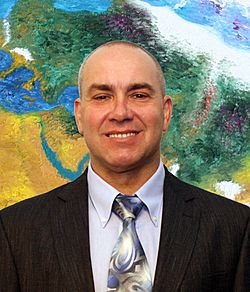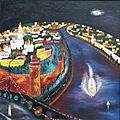Sergey Zagraevsky facts for kids
Sergey Zagraevsky (Russian: Сергей Вольфгангович Заграевский, Hebrew: סרגיי זגרייבסקי) was a talented artist from Russia and Israel. He was born on August 20, 1964, and passed away on July 6, 2020. Sergey was known for many things: he was a painter, someone who studied the history of buildings (an architectural historian), a writer, and a theologian (someone who studies religion).
Contents
About Sergey Zagraevsky
Sergey Zagraevsky was the son of Wolfgang Kawelmacher, who was also an architectural historian. His mother, Inna Zagraevsky, was a poet and writer.
Early Life and Education
Sergey started painting when he was still in school. His very first art teacher was a famous Russian painter named Tatiana Mavrina.
Later in his life, Sergey taught at different universities. He shared his knowledge at the Moscow Institute of Restoration Arts and the Russian University of Intellectual Property. He also taught at the Vladimir-Souzdal Museum.
His Work and Studies
Sergey was very interested in old Russian buildings, especially those made of white stone. He also studied the early architecture of Moscow. He looked at how buildings in ancient Russia were connected to styles from Europe, like Romanesque and Gothic art.
He earned a special degree called a doctoral thesis for his research on buildings in North-Eastern Russia.
Sergey was also the main editor for a big art guide called "United Art Rating". He wrote many books about philosophy, religion, and the history of buildings. He even wrote stories for children and many articles where he shared his thoughts on art. He also started "RusArch," which is an online library for studying the history of old Russian architecture.
Achievements and Languages
Sergey achieved many important things in his life. He earned a PhD in technique in 1992 and a doctorate in architecture in 2004. He became a Professor in 2005. He was also a member of several important groups, like the Russian Art Critics Academy and the Writers Union of Russia. He was honored as a "culture worker" of Russia and became a member of the Russian Academy of Arts.
Sergey could speak many languages! He knew Russian, English, Hebrew, German, French, and even Esperanto.
Sergey Zagraevsky passed away on July 6, 2020, because of heart problems.
Sergey's Art Style
Sergey Zagraevsky's paintings are special. They are not exactly like classic primitive art or Naïve art, but they are close to a style called "primitivism". This style is used by artists who have learned a lot about art but choose to paint in a simpler, almost childlike way. Famous artists like Paul Gauguin and Pablo Picasso also used this style sometimes.
What Makes His Art Unique?
Sergey's landscape paintings often look "childish" in a fun way. For example, he sometimes used a "reverse perspective," which means things that are far away might look bigger than they should. He didn't use chiaroscuro, which is a way of using light and shadow to make things look real. Instead, he used bright, open colors that make his paintings look cheerful, much like children's drawings.
His paintings usually don't show humor or violence. This also makes them feel innocent and pure, like art made by kids.
Around the year 2000, Sergey's art became a bit more general but still kept its bright colors. The details were drawn less carefully, but you could still see that an experienced artist made them. His lines were steady, and he was very skilled at painting and drawing. He always made sure his pictures had a good balance of shapes and colors.
Some things you might often see in his art include:
- A "flattened" sun
- Short, squat trees with big roots
- Water with many different colors
- Flowers that look like they came from a drawing album
- Windows that glow with light
The famous poet and singer Bulat Okudzhava once wrote about Sergey Zagraevsky in the 1990s:
- When he moves on a picture his fist,
- God is at his assist.
- God is with him all his way.
- That is the painter Sergey.
Sample Works
Selected Books
Sergey Zagraevsky wrote many books on different topics.
Books on Architecture History
He wrote several books about the history of buildings, especially old Russian architecture. Some examples include:
- Jury Dolgoruky and ancient Russian white stone architecture
- Architecture of North-Eastern Russia at the end of XIII–early XIV c.
- New researches of Vladimir-Suzdal museum’s architectural monuments
Books on Theology
He also wrote books about theology, which is the study of religious beliefs. Some of these include:
- Jesus of Nazareth: life and teaching
- God is no murderer
- New Christian philosophy
Literature and Memoirs
Sergey also wrote stories and his own life experiences:
- Twelve months. This was a book written especially for children.
- My XX century. These were his memoirs, which are like a personal story of his life.
- Ivanushka in the Land of tales. This was a trilogy, meaning a series of three books.
Art Catalogues
There are also catalogues that show his art works:
- Sergey Zagraevsky. — М., 1998.
- Sergey Zagraevsky. — М., 2007.
Images for kids
See also
 In Spanish: Serguéi Zagrayevski para niños
In Spanish: Serguéi Zagrayevski para niños









